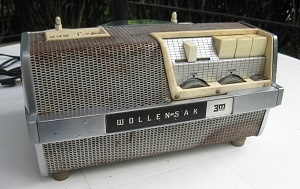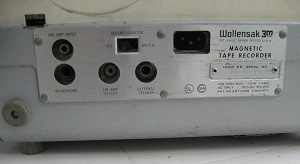Vintage Audio: Wollensak 1500 Series Tape Recorders | Telos Alliance
By The Telos Alliance Team on May 19, 2016 4:29:00 PM
 Vintage Audio: Wollensak 1500 Series Tape Recorders
Vintage Audio: Wollensak 1500 Series Tape Recorders
Anyone who worked for the high school AV club or college media services department in the late ‘60s or 1970s remembers the Wollensak 1500 series reel-to-reel recorders. Along with the RCA hand-threaded 16 mm projectors, they were the bread and butter of instructional media. The hallmark of these devices was their ease of use and indestructible design. Get ready for a flashback to your adolescence, when all you needed to know about tape recorders was 'PLAY-RECORD-STOP', as we peer beneath that white and chrome exterior of Wollensak 1500 tape recorders.
Wollensak had a long history before tape recorders were even invented, being founded in 1899 by Andrew Wollensak to manufacture camera shutters. The company was heavily involved in cameras and photography for its first 50 years, and in the early 1950s, Wollensak was purchased by the Revere Camera Company of Rochester NY. Revere initially wanted Wollensak for its shutter and lens capabilities. But it was also about this time that Revere began to branch out from cameras to tape recorders. The fledgling tape recorder product line was handed off to Wollensak, and recorders were sold under the 'Revere-Wollensak' brand. Wollensak was charged with refining the product and creating a rugged portable machine. The famous 3-key 'PLAY-RECORD-STOP' and FF/REW slider transport evolved, along with rugged vacuum tube electronics, and the 1500 series was born in 1956.
The T-1500 was based on the original Revere design, and was in production for about ten years. In 1967, the T-1500SS was introduced. It replaced the original vacuum tube electronics with a solid state circuitry. The Wollensak went stereo in 1958 with the T-1515. These were more popular in the consumer market; few were seen in AV departments.
A field recording model was in production from 1960-62. The T-1520/TS could be powered by either 12 VDC car battery or 120 VAC. The idea never caught on, and was perhaps the least successful model. The final AV model was the T-1520AV. It added auto-level recording, and was in production from 1969-1981. When 3M announced this machine was being discontinued, there was a scramble for the remaining machines and spare parts.
Audio specs for the 1500SS were typical of 1960s AV gear. Frequency response 40-15,000 +/- 3 dB, distortion less than 5 percent. Signal-to-noise, 50 dB +/- 4 dB. All input and output connectors are unbalanced, either RCA or ¼ inch phone jacks.
In 1960, Revere/Wollensak was bought out by 3M, and became known as '3M Mincom Division'. Operations were moved to St. Paul, MN. 3M manufactured (among other things) magnetic tape, and wanted to branch out to tape recorders on which to play 3M tape. Revere camera had a reputation as a budget brand, and 3M wanted to be in the high-quality recorder business. Therefore, the Revere connection soon disappeared, although the 3000 AV was sold briefly under the 3M Revere label. Subsequent machines were sold exclusively under the 3M Wollensak brand.
These machines were described as portable. But, as with most of the AV gear from the 60s and 70s, portable merely meant that it had a handle on it. The T-1500 weighed in at just over 18 lbs. Anyone who worked for media services in those days quickly developed arm and upper body strength lugging Wollensaks and 16 mm projectors around campus.
The 1500 series was marketed primarily to the education and consumer markets. A few found their way into radio stations, particularly small market and college operations. The audio specs weren't broadcast quality, and inputs/outputs were unbalanced, but they could take all the abuse that operators could dish out and keep on working. And yes, you could actually edit tape on them. Although there wasn't room to mount a splice block on the recorder, by precisely measuring the distance from the head to the splice block, and index mark was defined. Then, it was just a matter of marking the tape on the index point, and backing it out to the splice block.
The end finally came for the Mincom Division when profit margins began to drop. This was largely due to the changing electronics marketplace, with an increasing number of less expensive Japanese imports becoming available. 3M put Wollensak up for sale, and it was purchased by a company who was primarily interested in the cassette duplicator product line. Production of reel and cassette recorders soon ceased. Eventually, the duplicator market was also flooded by cheaper imports, and the company went out of business for good.
3M must have made 1500s by the thousands, and they are still sought out by collectors. A large number can usually be found under the 'vintage electronics' category on eBay. Service manuals and most parts are readily available online. A humorous point in the service manual is that no lubrication is necessary, since these machines are lubricated for life. Clearly, not even the service department at Wollensak expected 1500s to be running in great numbers some fifty years after their manufacture. Cleaning off the hardened remnants of the old grease and applying lubriplate is an essential part of bringing these machines back to life.
While the name Wollensak is synonymous with  the 1500 series, the company made many tape recorders, and later cassette machines. The 3000 AV preceded the 1500, and was truly a battleship. It was one of the last Revere designs. Wollensak's first suitcase cassette machine for the AV market was the 2515/2520. A handheld cassette machine was available in the early 70s, the model 400. The 6000 series eventually replaced the 1500 series, but were not nearly as robust.
the 1500 series, the company made many tape recorders, and later cassette machines. The 3000 AV preceded the 1500, and was truly a battleship. It was one of the last Revere designs. Wollensak's first suitcase cassette machine for the AV market was the 2515/2520. A handheld cassette machine was available in the early 70s, the model 400. The 6000 series eventually replaced the 1500 series, but were not nearly as robust.
Two Wollensak 1500s can be found in the attic, a T1500 and the 1500SS which was used for the photo shoot. They appear identical, except for the record level indicators. The T1500 has a neon bulb, while the later 1500SS has an analog meter. Both were cast offs from a college foreign language department in the 1970s although the details are murky. They are in working condition, although probably in need of new rubber and a tune-up.
Telos Alliance has led the audio industry’s innovation in Broadcast Audio, Digital Mixing & Mastering, Audio Processors & Compression, Broadcast Mixing Consoles, Audio Interfaces, AoIP & VoIP for over three decades. The Telos Alliance family of products include Telos® Systems, Omnia® Audio, Axia® Audio, Linear Acoustic®, 25-Seven® Systems, Minnetonka™ Audio and Jünger Audio. Covering all ranges of Audio Applications for Radio & Television from Telos Infinity IP Intercom Systems, Jünger Audio AIXpressor Audio Processor, Omnia 11 Radio Processors, Axia Networked Quasar Broadcast Mixing Consoles and Linear Acoustic AMS Audio Quality Loudness Monitoring and 25-Seven TVC-15 Watermark Analyzer & Monitor. Telos Alliance offers audio solutions for any and every Radio, Television, Live Events, Podcast & Live Streaming Studio With Telos Alliance “Broadcast Without Limits.”
More Topics: Vintage Radio Technology
Recent Posts
Subscribe
If you love broadcast audio, you'll love Telos Alliance's newsletter. Get it delivered to your inbox by subscribing below!